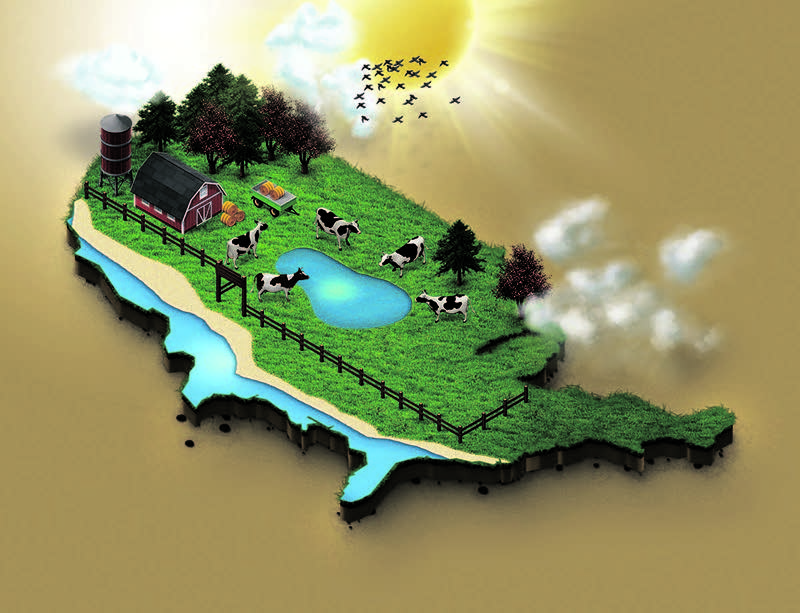During our class, Less is More: Getting to One Can of Garbage a Year, we talk about the three familiar Rs – Reduce, Reuse, and Recycle. After we discuss these three in order of importance, we ask folks to identify more Rs to move their thinking further upstream. Their suggestions include: Repurpose, Resist, Restore, Repair, Refuse, Reconnect, and Reimagine. Practicing any or all of these behaviors can rehabilitate our planet. Choose the actions that appeal to you and work them into your daily habits. We can all be part of the RE-Generation, no matter when we were born!
Another R that is getting more attention now is Regenerate. According to Wikipedia, “the term “regenerative” describes processes that restore, renew or revitalize their sources of energy and materials, creating sustainable systems that integrate the needs of society with the integrity of nature… Regenerative and sustainable are essentially the same thing except for one key point: in a sustainable system, lost ecological systems are not returned to existence. In a regenerative system, those lost systems can ultimately begin “regenerating” back into existence. Put more simply, regenerative systems create a “better” world than we (humans) found it, now and into the future.”
While learning more about this topic, I came across several types of regenerative practices including regenerative building and regenerative design. As mentioned above, the purpose of these approaches is to make a system better, healthier, and more resilient. At the end of this essay, are some links about Regenerative Buildings, Cities, and Public Spaces, as well as Regenerative Agriculture. The focus of all of these regenerative practices is to improve and enhance Nature’s systems.
I have been interested in food and food systems since serving on the curriculum committee for the NWEI (now known as Eco-Challenge). Their discussion courses point out that food and health are interconnected for both the Earth and its inhabitants, both human and non-human. After learning more about food over twenty years ago, our family made a point of shopping the edges of the grocery store. Why? Because that is where we find the produce and less processed foods. We also decided to buy mostly organic foods, considering them to be part of our health maintenance and insurance. So far, these habits have paid off for us; we are both 70, and neither of us takes medications.
I am very hopeful about the idea of Regenerative Agriculture, which promotes the practice of restoring the capacity of soils to sequester carbon and keep it out of the atmosphere, thereby limiting temperature rise. Thus, Regenerative Agriculture methods have the ability to combat climate change. This is exciting to me, and I want to share the following information.
• According to Green America: “The global climate solution is not possible without addressing the impact of (conventional) agriculture which contributes upwards of 1/3 of the global greenhouse gas emissions from human activities. Regenerative agriculture is key to transition agriculture from contributing to the climate crisis to helping solve it. According to Ohio State soil physicist Dr. Rattan Lal, “A mere 2 percent increase in the carbon content of the planet’s soils could offset 100 percent of all greenhouse gas emissions [currently] going into the atmosphere.”
• The Intergovernmental Planet on Climate Change (IPCC) says, “Leveraging the mitigation potential in the (Agriculture, Forestry and Other Land Use) sector is extremely important in meeting emission reduction targets.”
In 2014, Project Drawdown was started by Paul Hawken with the goal of identifying the point at which greenhouse gas concentrations in the atmosphere begin to decline. That was the subject of his best-selling 2016 book, Drawdown: The Most Comprehensive Plan Ever Proposed to Reverse Global Warming, which describes when and how humanity can reach drawdown. The project involved evaluating the 100 most promising solutions to the environmental crisis for cost and effectiveness. The results surprised the researchers themselves. The best-performing sector was not “Transport” or “Materials” or “Buildings and Cities,” or even “Electricity Generation.” It was the sector called “Food,” including how we grow our food, market it, and use it. Of the top 30 solutions, 12 were various forms of regenerative agriculture, including silvopasture, tropical staple trees, conservation agriculture, tree intercropping, managed grazing, farmland restoration, and Multistrada agroforestry. Regenerative Agriculture practices are ranked #11 out of 100 practices that reduce carbon.
For these reasons adopting Regenerative Agriculture makes plenty of sense. But wait! There’s more! Conventional agriculture strips nutrients out of the soil. These are the very nutrients that plants need to provide us with healthful food full of vitamins and minerals. Regenerative Agriculture restores and improves not only the health of the land but makes the food we eat more nourishing and healthful for us.
Another very important reason to support Regenerative Agriculture is found in an article published in YES! Magazine: “The soil is the historical root of American prosperity, the foundation of our country. But since the American Revolution, our nation’s soils have lost half their organic matter—half their natural fertility. Policies that promote efforts to rebuild healthy soils offer fertile ground to help restore prosperity to family farms and farming communities. Reinvesting in our soils is a natural infrastructure program, a sound investment in the foundation and future of America. This would not only put a lot of carbon in the ground, but it would also reduce the environmental damage from agrochemical use and help bring life back to the land and rural communities. Having more people on the land isn’t the problem, it’s the solution.”
I hope you will take the time to give thought to the kind of agriculture system you think is best for the health of everything and everyone, and then make the commitment to support it. It truly does make a difference in so many ways. Modern Farmer sums it up: “This is how land should be taken care of and food should be grown – with benefits for the environment and the consumer.”
Check out this wonderful movie that demonstrates how Regenerative Agriculture rehabilitates and restores the land at The Biggest Little Farm https://www.biggestlittlefarmmovie.com
For more info:
Building: https://bit.ly/31aaZwa
Regenerative Cities: https://bit.ly/2Ua1qeT
Regenerative Design: https://bit.ly/2RE9vqG
Regenerative Agriculture: Yes Magazine: https://bit.ly/38OvCR2 CivilEats.com: https://bit.ly/2S2yWBc Climaterealityproject.org: https://bit.ly/2tS4C4s
Betty Shelley is a Master Recycler (class #2), a former Metro Recycling Information Specialist, an Agent of Change, and the founder of Reduce Your Waste Project. Betty found Northwest Earth Institute in 1993 when it was founded in Portland. The NWEI discussion courses made her more aware of the choices we make as well as the consequences of those choices. Since 2006, Betty and her husband, Jon, have had just one 35-gallon can of garbage per year. The Shelleys offer the class “Less is More: Getting to One Can of Garbage a Year”. reduceyourwasteproject.com







2 Comments
Pingback:
Kifa
This is a very interesting topic of discussion. When I was in school, it was all about the 3 R’s – reduce, reuse and recycle. Now more R’s are on the list! When did that happen? The idea of regenerative agriculture is very intriguing. It is the need of the hour.